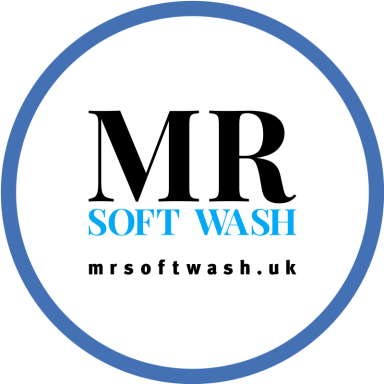Mr Softwash Ltd
On concrete, patios, driveways & walls light green algae, moss & organic growth can flare up because of one of, or a combination of, these reasons:
1. The grouting has failed and is in very poor condition. This gives the algae lots of cracks to hide in and then flare up again. Water lodges in the cracks, which encourages regrowth of the algae.
2. The grass lawn is higher than the patio so what happens is the cut grass blows down onto the patio and then decomposes, breeding algae at the same time. We've often seen a flare up of green algae where grass cuttings have been left on a clean path or drive.
We've noticed this happening when grass cuttings fall off the lawnmower moving from one lawn to another. And of course once algae gets a hold in one place it's easy for it to spread.
3. The drainage is poor and "pooling" is occurring. Patios need a good drainage system as pooling will encourage regrowth of algae. Sandstone is especially vulnerable and if it pools water it will need regular treatments to keep on top of the tendency for algae to recolonise.
4. placing plant pots, and/or garden furniture, on the patio after the surface has been cleaned.These quite often overflow and spill soil and other organic material onto a patio. And of course algae can grow under them and spread. Also, the outside of terracotta pots often have a heavy biofilm that will encourage re-colonisation of a treated surface.
5. Moss could be falling from the roof onto the patio and doing the same as the grass in point 2.
6. Leaves from trees could be falling onto the patio and doing the same as grass in point 2.
7. Hanging baskets on walls also encourage organic growth on walls.
Because of the above reasons, including the amount of shade and exposure the patio/ walls get, and depending on the surface and general environment, a light re-treatment wtih Biowash in the autumn, to treat the flare-up of green algae after a summer treatment, is sometimes necessary to be able to keep a patio clean all year long.
This is because the active ingredient in a Biowash is still relatively fresh when the damp, mild conditions come in, thus offering a better chance of keeping the surface free from re-colonising.
The cost of regular re-treatments should be relatively low, as there is very little preparatory work needed compared to a new clean of a surface that hasn't been cared for.
Another approach would be to apply a Biowash in the summer to get the surface initially clean and then give a treatment of a Biowash in the autumn/winter as ongoing maintenance.
we cannot control whether our customers sweep up leaves and grass cuttings, or control their placement of plant pots and items of garden furniture. And of course the quality of grouting on patios varies enormously, and is itself subject to decay leading to it becoming a catchment area for algae spores.
If patios, paths, driveways & render have been neglected for many years, lichen can grow deeply into the surface and be very hard to remove.
Because sandstone and render is a relatively soft it is not advisable to use high pressure jet washing. This can damage the surface layer and if live growths are present will rip out the roots, further damaging the soft surface.
Soft washing with a Biowash
1. Give the surface a light, low pressure, power wash prior to treating with a Biowash. This will clear loose matter from the surface and remove some of the more shallow-rooted growths.
2. Treat the surface with a Biowash (5:1) to kill the algae and lichen that are usually responsible for making surface look "dirty".
3. Apply a Biowash liberally by brush – as a post-treatment "spot cleaner" – to areas of deep residual staining and leave for 15-60 minutes to activate. Use a medium soft brush to brush-in the Biowash. A 9 inch brush can be useful for awkward areas. For very heavy staining (e.g. by black lichen, "black dots"), you may find a slightly stiffer brush useful.
Quick tips:
- Set your jet washer to low pressure if you have a variable control, and/or fit with a fan jet, and hold well back from the surface.
- We've found that a light jet wash is more effective than sweeping the surface clean of loose matter, or using a blower.
- A Biowash continues to deep clean surfaces such as sandstone, concrete & render for several months following a treatment.
All these things a trained and experienced
Soft washing contractor can advise on.
We need your consent to load the translations
We use a third-party service to translate the website content that may collect data about your activity. Please review the details in the privacy policy and accept the service to view the translations.

